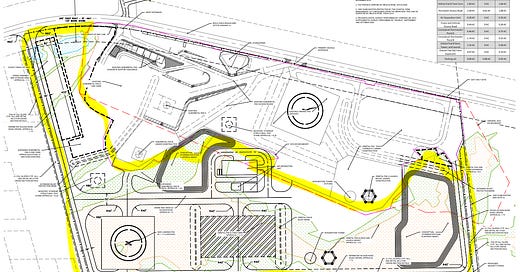The Army Corps of Engineers puts Starbase on Ice
SpaceX has no one else to blame but themselves
I’m back on the SpaceX beat. Will it ever end? I suspect that we’re getting pretty close to that point. After the FAA delayed release of the Final Programmatic Environmental Assessment (PEA) for the third time, the focus was on Fish and Wildlife service and their ongoing review of proposed Starship operations under the Endangered Species Act.
For background, SpaceX and FAA submitted a Draft PEA for the Boca Chica launch site in September of last year. I’ve been adamant since day one that the document they submitted, which is required under the National Environmental Policy Act (NEPA), is woefully and historically inadequate. I have posited that it was evidence of systematic regulatory capture and signs of a burgeoning oligarchy where Billionaires can get what they want, laws be damned.
Here’s an overview of the topic if you are interested:
I have been theorizing ways in which this NEPA-subject document could be approved by FAA (who has final say) without the approval getting immediately held up in a protracted years long court battle, both on this Substack and on my Twitter account. There are numerous agencies involved here, each with their own agenda. For all the discussions I’ve presented about EPA, FAA, TCEQ, FWS, DOI, etc, what I didn’t consider was the parallel permitting process being done by the Army Corps of Engineers. The Corps have permitting authority over any land development involving “Waters of the United States.” Briefly, this nebulous and often contentious term refers to lakes, ponds, rivers, marshes that are connected to interstate watersheds. If you want to build a gas pipeline that goes under a tributary to the Colorado river, for example, you’re gonna need Army Corps approval, especially to assure compliance of the Clean Water Act.
Because Starbase involves impacting “10.94 acres of mud flats, 5.94 acres of estuarine wetlands, and 0.28 acres of non-tidal wetlands,” the Army Corps must issue a permit to allow that to happen. This is separate from the NEPA/PEA process but involves lots of the same questions. Both NEPA and Corps permitting must be satisfied to proceed.
In March of 2021, SpaceX submitted an Application to the Galveston Army Corps office for this project. Below is a drawing of the conceptual plans. The areas inside the yellow highlight are wetlands covered under this permit.
In May 2021, the Corps sent a letter to SpaceX outlining deficiencies with the application. This included an inadequate “Compensatory Mitigation Plan” which is part of the The Navigable Waters Protection Rule that stipulates backfilled or developed wetlands must be offset by project elsewhere. The company also didn’t provide justification for the project, specifically they didn’t provide a “No Action Alternate” as required under 404(b)(1) of the Clean Water Act. This requirement is nearly identical to the one under NEPA that requires projects must give alternate sites that.
In September, SpaceX and FAA submitted the Draft Programmatic Environmental Assessment (PEA), which I have covered in exhausting detail. Importantly, the PEA specifically relies on the Corps’ permitting process:
With the replacement of lost wetland functions through the Section 404 permitting and mitigation process, construction impacts on wetlands are not anticipated to be significant per the significance thresholds identified at beginning of Section 3.9.4.
While the Army Corps’ permit is indeed a separate approval, as noted elsewhere, importantly: the NEPA significance threshold determination is determined as satisfactory because this permitting process exists.
Most recently, on March 7th of this year, SpaceX was sent a letter by the Army Corps. In it, the agency notes that in May 2021, September 2021 and October 2021, SpaceX was asked to provide crucial information that the Corps needs to approve the Wetland Permit Under the Clean Water Act yet failed to do so:
As of the date of this letter the Corps has not received the public interest review or a compensatory mitigation plan. The Corps did receive a response to comments and an alternatives analysis on October 7, 2021, and have concluded that the overall project purpose and siting criteria are so restrictive as to constrain the range of alternatives that must be considered under the 404(b)(1) Guidelines. Therefore, your Department of Army Permit application is withdrawn.
Now, SpaceX can re-initiate permitting at any time. But this is clearly an impasse. The Corps does not have adequate information to issue a permit and they would not have issued this letter had the two parties (SpaceX and The Corps) been close to a resolution.
Put another way: no permit, no Starbase expansion.
What about the PEA?
Because so much of my work has been focused on the FAA and NEPA side, people naturally want to know what this means for NEPA approval and FAA issuance of a Experimental Launch permit. As stated above, the Clean Water Act section 404 obligations in the PEA are essentially punted over to the Corps, who have said: “Yeah this ain’t going anywhere.”
Because the 404 permit is about construction and all my favorite SpaceX fans want to see rockets launch, the question then becomes: “Well, can’t they just approve the launches and save the other stuff for later?”
The answer is maybe. But probably not. And here’s why, from the Army Corps
The Corps also recommends that SpaceX re-address the No Action Alternative in its analysis. Specifically, SpaceX needs to describe impacts to ongoing operations if the permit is denied. For instance, in a February 10, 2022 announcement, SpaceX stated they will shift operations to Kennedy Space Center if the FAA requires an Environmental Impact Statement. This alternative was eliminated from analysis in your October 2021 submission but seems to represent either the No Action alternative or a practicable off-site alternative requiring detailed analysis.
The key phrase here is “No Action Alternative.”
A foundation of NEPA and other environmental impact laws, such as section 4 of the Department of Transportation is to compare and contrast environmental impacts for variations of projects that meet the same need. In the PEA, SpaceX and the FAA do not provide a “No Action Alternative” under NEPA. This is an alternate site that can serve the same function as the proposed site. Boca Chica was presented in the document as a testing facility that can handle 5-15 launches per year. They provided no other sites that could serve this purpose. Providing an alternate would mean that they’d have to compare impacts at Boca Chica vs the Alternate.
SpaceX avoided tons of NEPA requirements by explicitly saying “no, Boca Chica is the only place we can do this.” So when Elon Musk holds a press conference and says in essence: “if the FAA doesn’t approve launches at Boca Chica, we can easily pivot elsewhere,” he has just invalidated the entire PEA. There is, in fact, a “No Action Alternative:” It’s the Kennedy Space Center in Florida.


Because Army Corps Permitting and NEPA have nearly identical “alternative” site criteria for determining the suitability of a project, the Corps has effectively killed the PEA. Should the FAA proceed with approval: the Army Corps, a federal agency responsible for infrastructure approval, put in writing that SpaceX failed to complete a fundamental requirement that is a large part of NEPA. You couldn’t ask for better ammunition in a lawsuit against the FAA that their decision was inadequate, arbitrary and capricious.
If that wasn’t enough: the Army Corps treats Clean Water Act and NEPA “Alternative” site criteria as essentially interchangeable. Read a decent primer on it here.
Simply Put: SpaceX isn’t going to get approval to launch anytime soon
Here are links to the documents referenced in this piece:
May 2021 Letter from the Army Corps of Engineers
March 2022 Letter Withdrawing SpaceX Clean Water Act Application







You were way ahead of the curve on this. Providing real alpha. Kudos.
Thank you for all your hard work and keeping us informed. I m glad someone is putting on the brakes.